Hospitality Destination Analysis: Planning, Policies, and Approaches
VerifiedAdded on 2023/01/17
|12
|3855
|77
Report
AI Summary
This report provides a comprehensive analysis of hospitality destinations, focusing on planning, policy approaches, and development strategies. The introduction defines hospitality destinations and their importance, using the Serengeti National Park as a case study. The main body delves into tourism policies, their objectives, and the reasons for government involvement in tourism development, including economic, social, and environmental considerations. It explores various policy approaches to managing destination development, such as quality tourism, environmental planning, community-based tourism, stakeholder approaches, boosterism, and economic approaches. The report also examines holistic tourism planning, outlining the steps involved, including assessment of tourist demand and supply, identifying tourism systems, and financial and human resource planning. The report covers tourism destination definition and life cycles. Overall, the report provides a detailed overview of the key elements involved in developing and managing successful hospitality destinations.
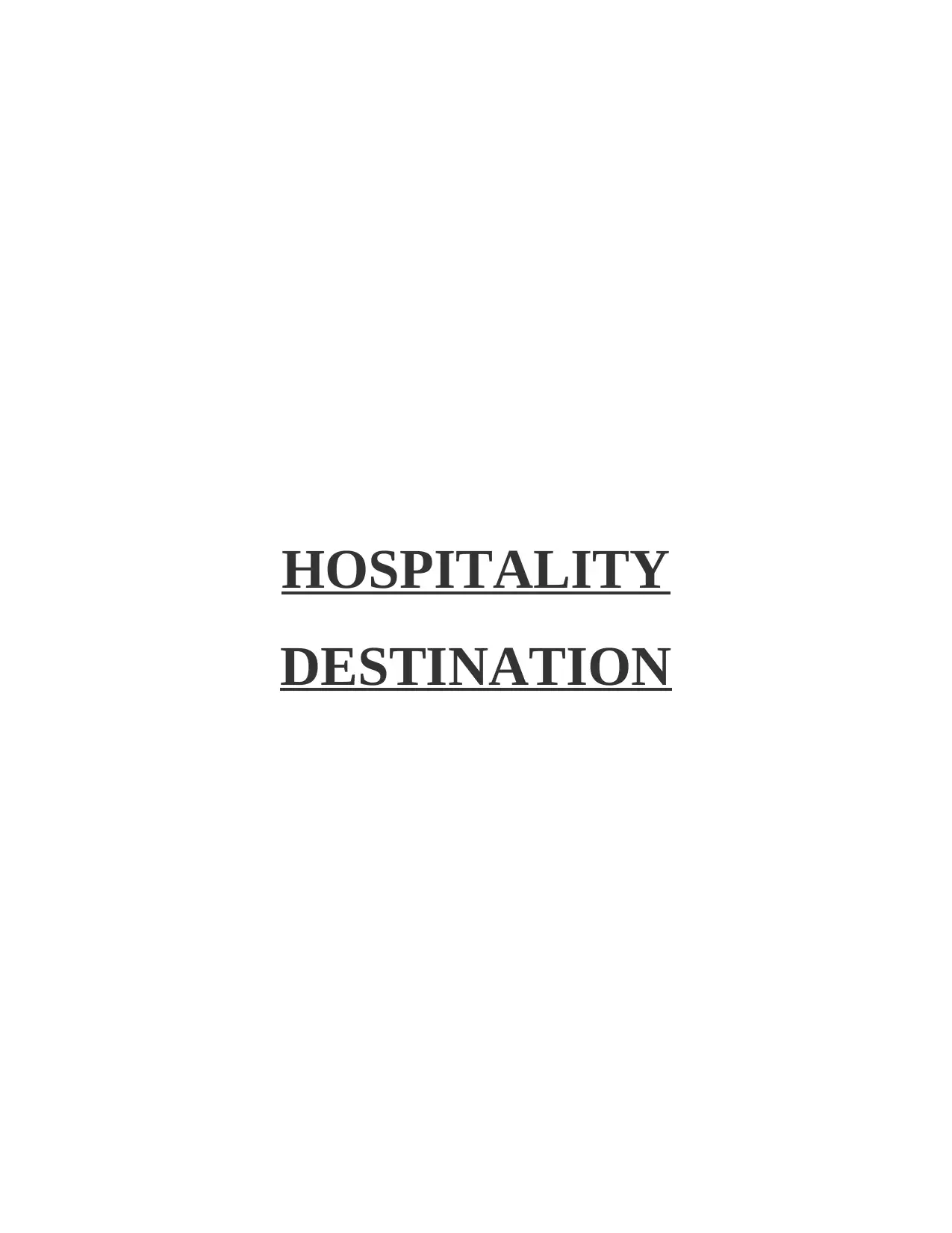
HOSPITALITY
DESTINATION
DESTINATION
Paraphrase This Document
Need a fresh take? Get an instant paraphrase of this document with our AI Paraphraser
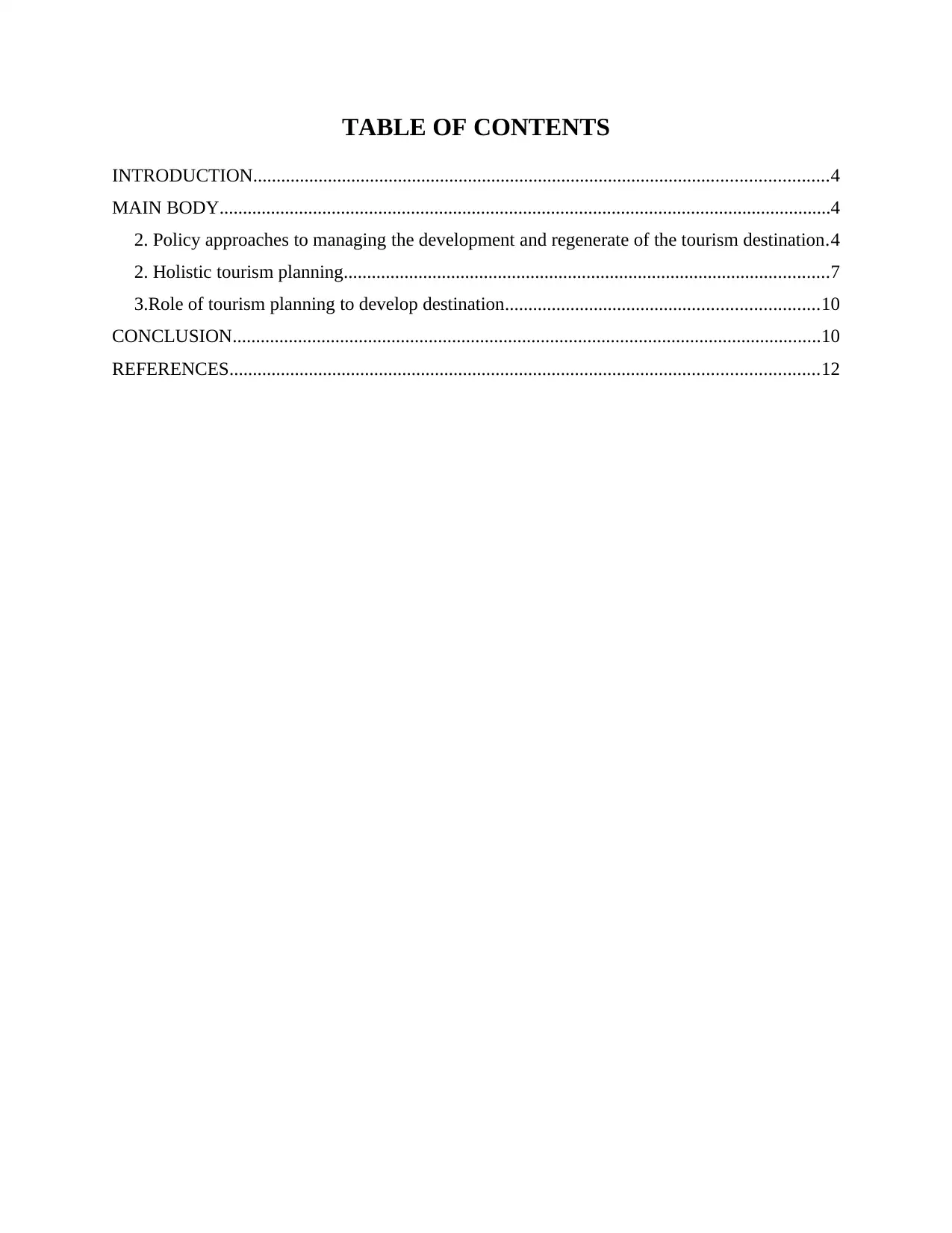
TABLE OF CONTENTS
INTRODUCTION...........................................................................................................................4
MAIN BODY...................................................................................................................................4
2. Policy approaches to managing the development and regenerate of the tourism destination.4
2. Holistic tourism planning........................................................................................................7
3.Role of tourism planning to develop destination...................................................................10
CONCLUSION..............................................................................................................................10
REFERENCES..............................................................................................................................12
INTRODUCTION...........................................................................................................................4
MAIN BODY...................................................................................................................................4
2. Policy approaches to managing the development and regenerate of the tourism destination.4
2. Holistic tourism planning........................................................................................................7
3.Role of tourism planning to develop destination...................................................................10
CONCLUSION..............................................................................................................................10
REFERENCES..............................................................................................................................12
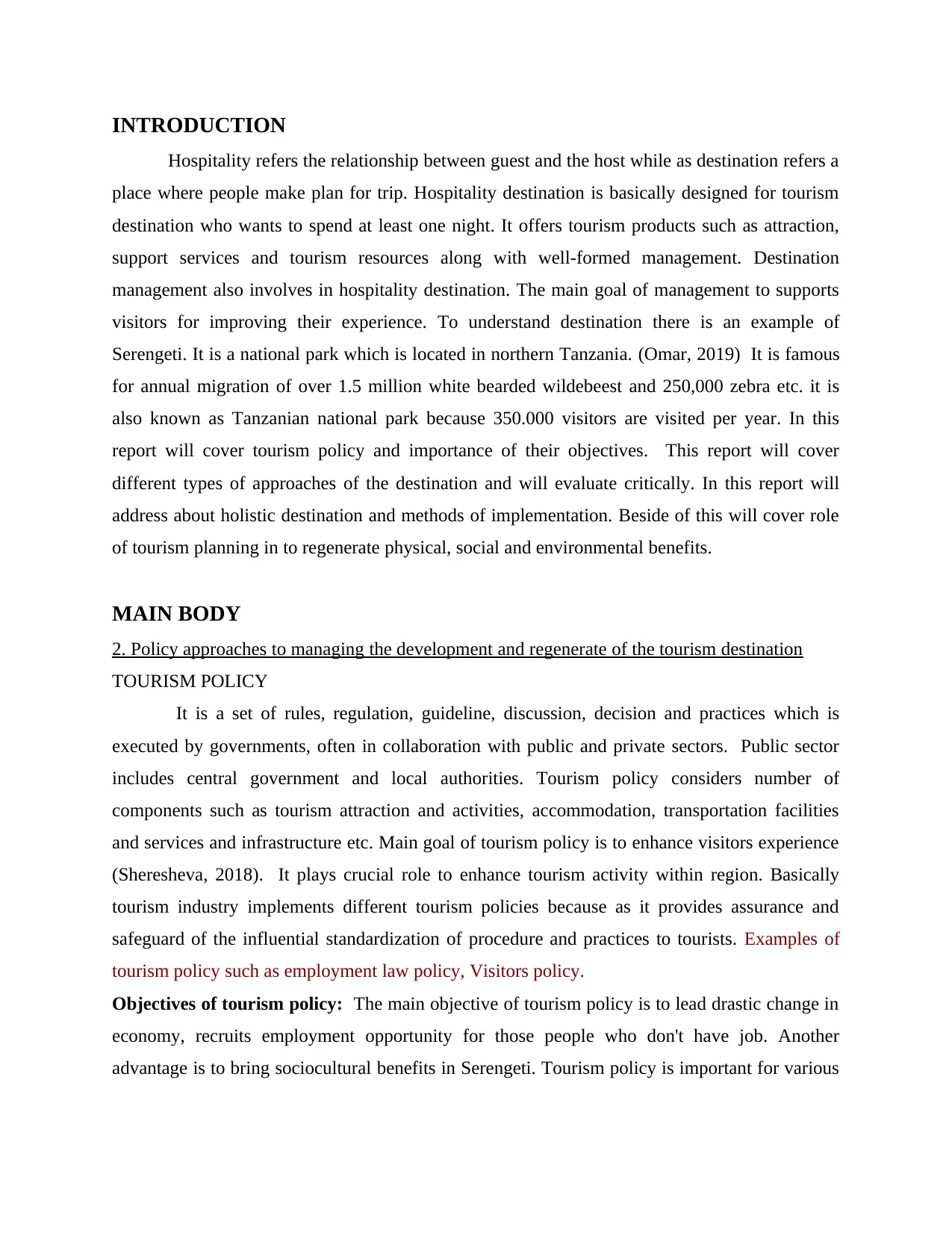
INTRODUCTION
Hospitality refers the relationship between guest and the host while as destination refers a
place where people make plan for trip. Hospitality destination is basically designed for tourism
destination who wants to spend at least one night. It offers tourism products such as attraction,
support services and tourism resources along with well-formed management. Destination
management also involves in hospitality destination. The main goal of management to supports
visitors for improving their experience. To understand destination there is an example of
Serengeti. It is a national park which is located in northern Tanzania. (Omar, 2019) It is famous
for annual migration of over 1.5 million white bearded wildebeest and 250,000 zebra etc. it is
also known as Tanzanian national park because 350.000 visitors are visited per year. In this
report will cover tourism policy and importance of their objectives. This report will cover
different types of approaches of the destination and will evaluate critically. In this report will
address about holistic destination and methods of implementation. Beside of this will cover role
of tourism planning in to regenerate physical, social and environmental benefits.
MAIN BODY
2. Policy approaches to managing the development and regenerate of the tourism destination
TOURISM POLICY
It is a set of rules, regulation, guideline, discussion, decision and practices which is
executed by governments, often in collaboration with public and private sectors. Public sector
includes central government and local authorities. Tourism policy considers number of
components such as tourism attraction and activities, accommodation, transportation facilities
and services and infrastructure etc. Main goal of tourism policy is to enhance visitors experience
(Sheresheva, 2018). It plays crucial role to enhance tourism activity within region. Basically
tourism industry implements different tourism policies because as it provides assurance and
safeguard of the influential standardization of procedure and practices to tourists. Examples of
tourism policy such as employment law policy, Visitors policy.
Objectives of tourism policy: The main objective of tourism policy is to lead drastic change in
economy, recruits employment opportunity for those people who don't have job. Another
advantage is to bring sociocultural benefits in Serengeti. Tourism policy is important for various
Hospitality refers the relationship between guest and the host while as destination refers a
place where people make plan for trip. Hospitality destination is basically designed for tourism
destination who wants to spend at least one night. It offers tourism products such as attraction,
support services and tourism resources along with well-formed management. Destination
management also involves in hospitality destination. The main goal of management to supports
visitors for improving their experience. To understand destination there is an example of
Serengeti. It is a national park which is located in northern Tanzania. (Omar, 2019) It is famous
for annual migration of over 1.5 million white bearded wildebeest and 250,000 zebra etc. it is
also known as Tanzanian national park because 350.000 visitors are visited per year. In this
report will cover tourism policy and importance of their objectives. This report will cover
different types of approaches of the destination and will evaluate critically. In this report will
address about holistic destination and methods of implementation. Beside of this will cover role
of tourism planning in to regenerate physical, social and environmental benefits.
MAIN BODY
2. Policy approaches to managing the development and regenerate of the tourism destination
TOURISM POLICY
It is a set of rules, regulation, guideline, discussion, decision and practices which is
executed by governments, often in collaboration with public and private sectors. Public sector
includes central government and local authorities. Tourism policy considers number of
components such as tourism attraction and activities, accommodation, transportation facilities
and services and infrastructure etc. Main goal of tourism policy is to enhance visitors experience
(Sheresheva, 2018). It plays crucial role to enhance tourism activity within region. Basically
tourism industry implements different tourism policies because as it provides assurance and
safeguard of the influential standardization of procedure and practices to tourists. Examples of
tourism policy such as employment law policy, Visitors policy.
Objectives of tourism policy: The main objective of tourism policy is to lead drastic change in
economy, recruits employment opportunity for those people who don't have job. Another
advantage is to bring sociocultural benefits in Serengeti. Tourism policy is important for various
⊘ This is a preview!⊘
Do you want full access?
Subscribe today to unlock all pages.

Trusted by 1+ million students worldwide
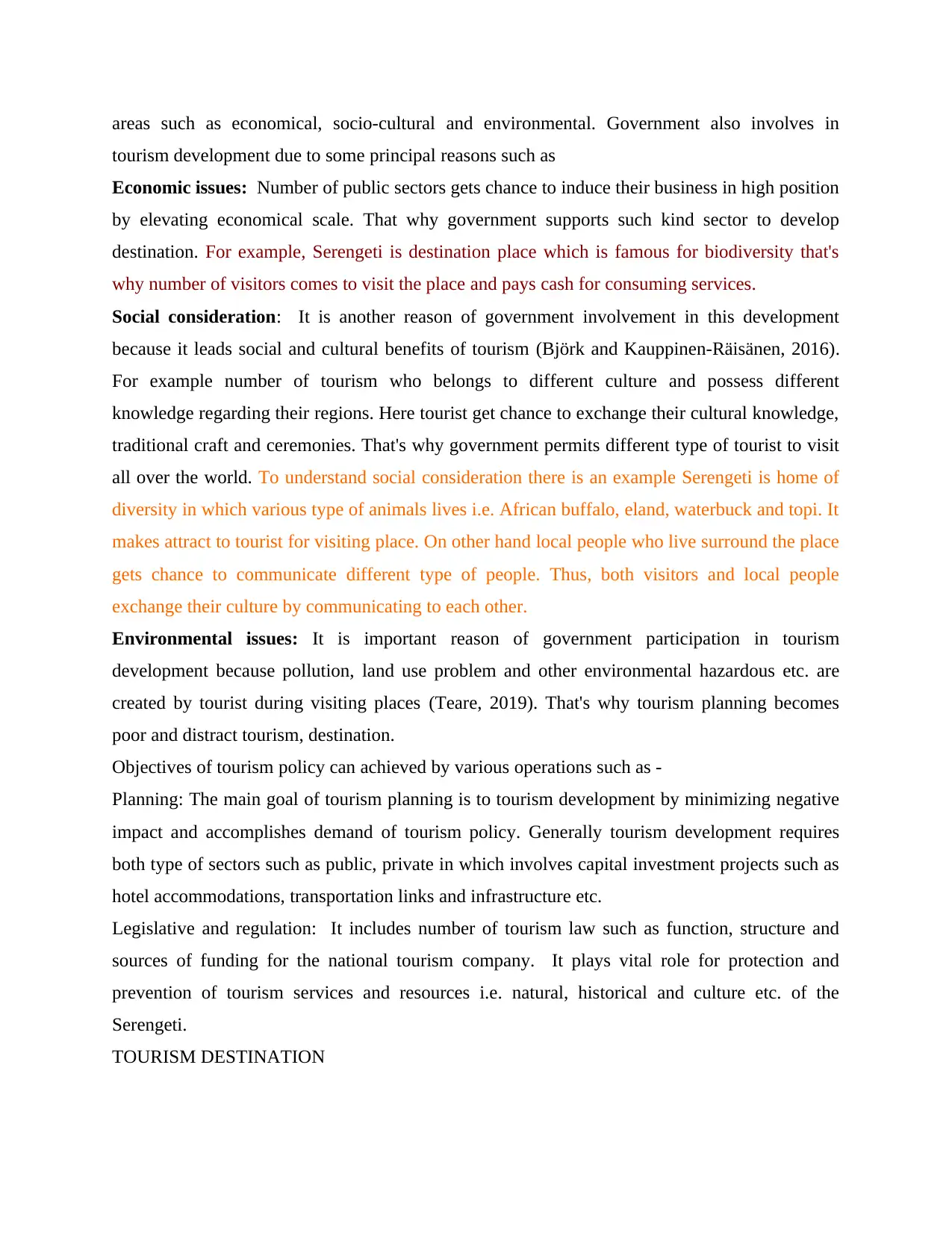
areas such as economical, socio-cultural and environmental. Government also involves in
tourism development due to some principal reasons such as
Economic issues: Number of public sectors gets chance to induce their business in high position
by elevating economical scale. That why government supports such kind sector to develop
destination. For example, Serengeti is destination place which is famous for biodiversity that's
why number of visitors comes to visit the place and pays cash for consuming services.
Social consideration: It is another reason of government involvement in this development
because it leads social and cultural benefits of tourism (Björk and Kauppinen-Räisänen, 2016).
For example number of tourism who belongs to different culture and possess different
knowledge regarding their regions. Here tourist get chance to exchange their cultural knowledge,
traditional craft and ceremonies. That's why government permits different type of tourist to visit
all over the world. To understand social consideration there is an example Serengeti is home of
diversity in which various type of animals lives i.e. African buffalo, eland, waterbuck and topi. It
makes attract to tourist for visiting place. On other hand local people who live surround the place
gets chance to communicate different type of people. Thus, both visitors and local people
exchange their culture by communicating to each other.
Environmental issues: It is important reason of government participation in tourism
development because pollution, land use problem and other environmental hazardous etc. are
created by tourist during visiting places (Teare, 2019). That's why tourism planning becomes
poor and distract tourism, destination.
Objectives of tourism policy can achieved by various operations such as -
Planning: The main goal of tourism planning is to tourism development by minimizing negative
impact and accomplishes demand of tourism policy. Generally tourism development requires
both type of sectors such as public, private in which involves capital investment projects such as
hotel accommodations, transportation links and infrastructure etc.
Legislative and regulation: It includes number of tourism law such as function, structure and
sources of funding for the national tourism company. It plays vital role for protection and
prevention of tourism services and resources i.e. natural, historical and culture etc. of the
Serengeti.
TOURISM DESTINATION
tourism development due to some principal reasons such as
Economic issues: Number of public sectors gets chance to induce their business in high position
by elevating economical scale. That why government supports such kind sector to develop
destination. For example, Serengeti is destination place which is famous for biodiversity that's
why number of visitors comes to visit the place and pays cash for consuming services.
Social consideration: It is another reason of government involvement in this development
because it leads social and cultural benefits of tourism (Björk and Kauppinen-Räisänen, 2016).
For example number of tourism who belongs to different culture and possess different
knowledge regarding their regions. Here tourist get chance to exchange their cultural knowledge,
traditional craft and ceremonies. That's why government permits different type of tourist to visit
all over the world. To understand social consideration there is an example Serengeti is home of
diversity in which various type of animals lives i.e. African buffalo, eland, waterbuck and topi. It
makes attract to tourist for visiting place. On other hand local people who live surround the place
gets chance to communicate different type of people. Thus, both visitors and local people
exchange their culture by communicating to each other.
Environmental issues: It is important reason of government participation in tourism
development because pollution, land use problem and other environmental hazardous etc. are
created by tourist during visiting places (Teare, 2019). That's why tourism planning becomes
poor and distract tourism, destination.
Objectives of tourism policy can achieved by various operations such as -
Planning: The main goal of tourism planning is to tourism development by minimizing negative
impact and accomplishes demand of tourism policy. Generally tourism development requires
both type of sectors such as public, private in which involves capital investment projects such as
hotel accommodations, transportation links and infrastructure etc.
Legislative and regulation: It includes number of tourism law such as function, structure and
sources of funding for the national tourism company. It plays vital role for protection and
prevention of tourism services and resources i.e. natural, historical and culture etc. of the
Serengeti.
TOURISM DESTINATION
Paraphrase This Document
Need a fresh take? Get an instant paraphrase of this document with our AI Paraphraser
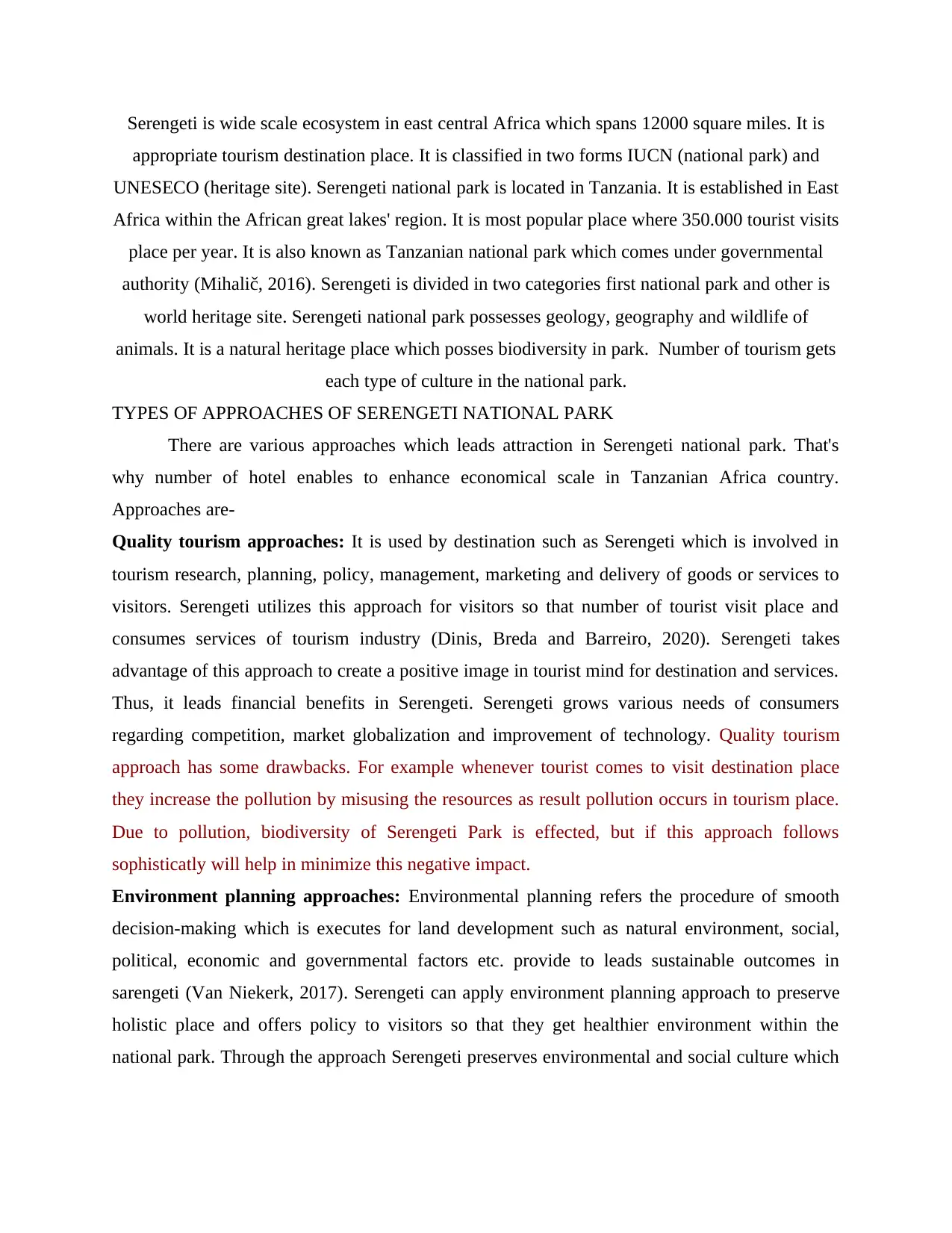
Serengeti is wide scale ecosystem in east central Africa which spans 12000 square miles. It is
appropriate tourism destination place. It is classified in two forms IUCN (national park) and
UNESECO (heritage site). Serengeti national park is located in Tanzania. It is established in East
Africa within the African great lakes' region. It is most popular place where 350.000 tourist visits
place per year. It is also known as Tanzanian national park which comes under governmental
authority (Mihalič, 2016). Serengeti is divided in two categories first national park and other is
world heritage site. Serengeti national park possesses geology, geography and wildlife of
animals. It is a natural heritage place which posses biodiversity in park. Number of tourism gets
each type of culture in the national park.
TYPES OF APPROACHES OF SERENGETI NATIONAL PARK
There are various approaches which leads attraction in Serengeti national park. That's
why number of hotel enables to enhance economical scale in Tanzanian Africa country.
Approaches are-
Quality tourism approaches: It is used by destination such as Serengeti which is involved in
tourism research, planning, policy, management, marketing and delivery of goods or services to
visitors. Serengeti utilizes this approach for visitors so that number of tourist visit place and
consumes services of tourism industry (Dinis, Breda and Barreiro, 2020). Serengeti takes
advantage of this approach to create a positive image in tourist mind for destination and services.
Thus, it leads financial benefits in Serengeti. Serengeti grows various needs of consumers
regarding competition, market globalization and improvement of technology. Quality tourism
approach has some drawbacks. For example whenever tourist comes to visit destination place
they increase the pollution by misusing the resources as result pollution occurs in tourism place.
Due to pollution, biodiversity of Serengeti Park is effected, but if this approach follows
sophisticatly will help in minimize this negative impact.
Environment planning approaches: Environmental planning refers the procedure of smooth
decision-making which is executes for land development such as natural environment, social,
political, economic and governmental factors etc. provide to leads sustainable outcomes in
sarengeti (Van Niekerk, 2017). Serengeti can apply environment planning approach to preserve
holistic place and offers policy to visitors so that they get healthier environment within the
national park. Through the approach Serengeti preserves environmental and social culture which
appropriate tourism destination place. It is classified in two forms IUCN (national park) and
UNESECO (heritage site). Serengeti national park is located in Tanzania. It is established in East
Africa within the African great lakes' region. It is most popular place where 350.000 tourist visits
place per year. It is also known as Tanzanian national park which comes under governmental
authority (Mihalič, 2016). Serengeti is divided in two categories first national park and other is
world heritage site. Serengeti national park possesses geology, geography and wildlife of
animals. It is a natural heritage place which posses biodiversity in park. Number of tourism gets
each type of culture in the national park.
TYPES OF APPROACHES OF SERENGETI NATIONAL PARK
There are various approaches which leads attraction in Serengeti national park. That's
why number of hotel enables to enhance economical scale in Tanzanian Africa country.
Approaches are-
Quality tourism approaches: It is used by destination such as Serengeti which is involved in
tourism research, planning, policy, management, marketing and delivery of goods or services to
visitors. Serengeti utilizes this approach for visitors so that number of tourist visit place and
consumes services of tourism industry (Dinis, Breda and Barreiro, 2020). Serengeti takes
advantage of this approach to create a positive image in tourist mind for destination and services.
Thus, it leads financial benefits in Serengeti. Serengeti grows various needs of consumers
regarding competition, market globalization and improvement of technology. Quality tourism
approach has some drawbacks. For example whenever tourist comes to visit destination place
they increase the pollution by misusing the resources as result pollution occurs in tourism place.
Due to pollution, biodiversity of Serengeti Park is effected, but if this approach follows
sophisticatly will help in minimize this negative impact.
Environment planning approaches: Environmental planning refers the procedure of smooth
decision-making which is executes for land development such as natural environment, social,
political, economic and governmental factors etc. provide to leads sustainable outcomes in
sarengeti (Van Niekerk, 2017). Serengeti can apply environment planning approach to preserve
holistic place and offers policy to visitors so that they get healthier environment within the
national park. Through the approach Serengeti preserves environmental and social culture which
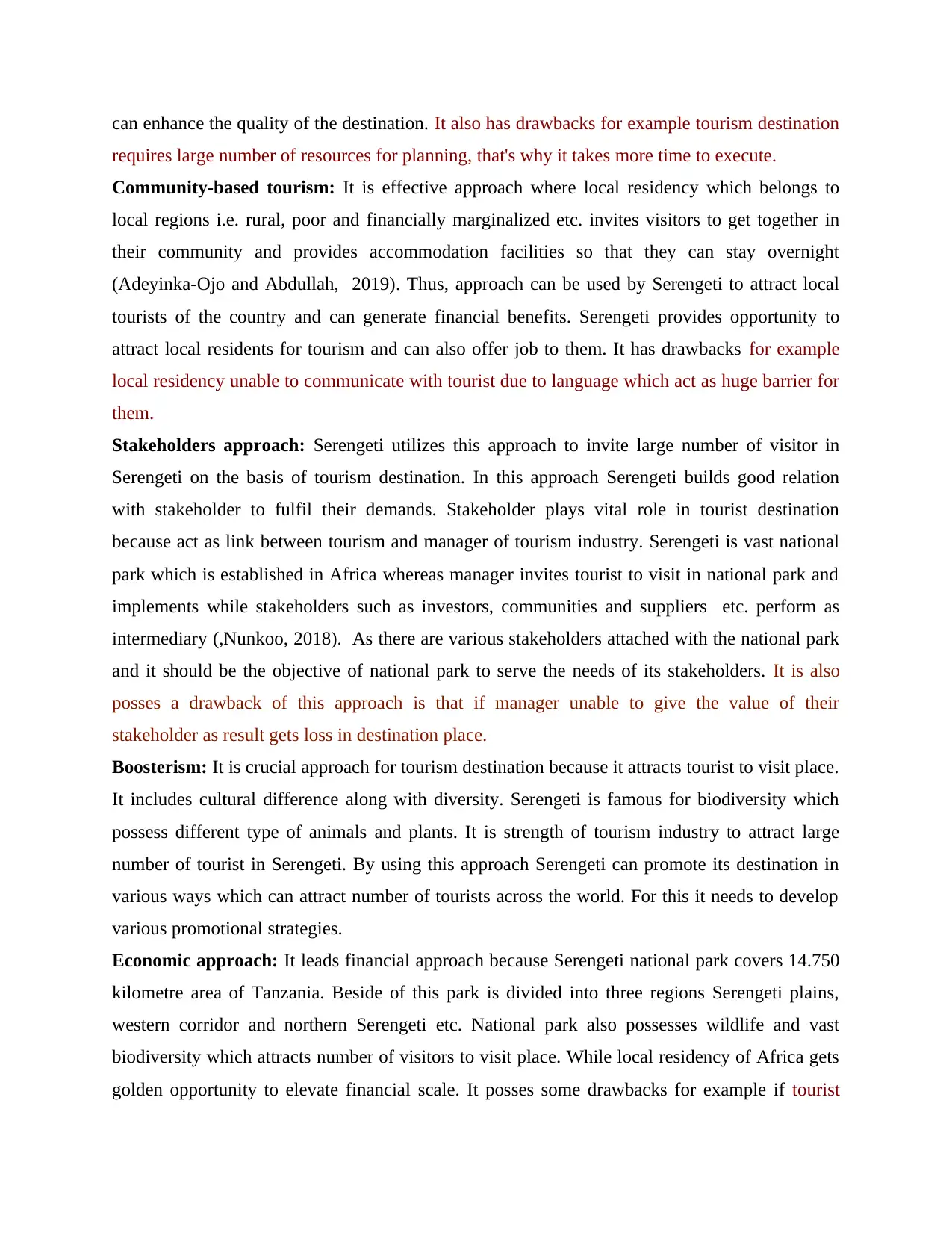
can enhance the quality of the destination. It also has drawbacks for example tourism destination
requires large number of resources for planning, that's why it takes more time to execute.
Community-based tourism: It is effective approach where local residency which belongs to
local regions i.e. rural, poor and financially marginalized etc. invites visitors to get together in
their community and provides accommodation facilities so that they can stay overnight
(Adeyinka-Ojo and Abdullah, 2019). Thus, approach can be used by Serengeti to attract local
tourists of the country and can generate financial benefits. Serengeti provides opportunity to
attract local residents for tourism and can also offer job to them. It has drawbacks for example
local residency unable to communicate with tourist due to language which act as huge barrier for
them.
Stakeholders approach: Serengeti utilizes this approach to invite large number of visitor in
Serengeti on the basis of tourism destination. In this approach Serengeti builds good relation
with stakeholder to fulfil their demands. Stakeholder plays vital role in tourist destination
because act as link between tourism and manager of tourism industry. Serengeti is vast national
park which is established in Africa whereas manager invites tourist to visit in national park and
implements while stakeholders such as investors, communities and suppliers etc. perform as
intermediary (,Nunkoo, 2018). As there are various stakeholders attached with the national park
and it should be the objective of national park to serve the needs of its stakeholders. It is also
posses a drawback of this approach is that if manager unable to give the value of their
stakeholder as result gets loss in destination place.
Boosterism: It is crucial approach for tourism destination because it attracts tourist to visit place.
It includes cultural difference along with diversity. Serengeti is famous for biodiversity which
possess different type of animals and plants. It is strength of tourism industry to attract large
number of tourist in Serengeti. By using this approach Serengeti can promote its destination in
various ways which can attract number of tourists across the world. For this it needs to develop
various promotional strategies.
Economic approach: It leads financial approach because Serengeti national park covers 14.750
kilometre area of Tanzania. Beside of this park is divided into three regions Serengeti plains,
western corridor and northern Serengeti etc. National park also possesses wildlife and vast
biodiversity which attracts number of visitors to visit place. While local residency of Africa gets
golden opportunity to elevate financial scale. It posses some drawbacks for example if tourist
requires large number of resources for planning, that's why it takes more time to execute.
Community-based tourism: It is effective approach where local residency which belongs to
local regions i.e. rural, poor and financially marginalized etc. invites visitors to get together in
their community and provides accommodation facilities so that they can stay overnight
(Adeyinka-Ojo and Abdullah, 2019). Thus, approach can be used by Serengeti to attract local
tourists of the country and can generate financial benefits. Serengeti provides opportunity to
attract local residents for tourism and can also offer job to them. It has drawbacks for example
local residency unable to communicate with tourist due to language which act as huge barrier for
them.
Stakeholders approach: Serengeti utilizes this approach to invite large number of visitor in
Serengeti on the basis of tourism destination. In this approach Serengeti builds good relation
with stakeholder to fulfil their demands. Stakeholder plays vital role in tourist destination
because act as link between tourism and manager of tourism industry. Serengeti is vast national
park which is established in Africa whereas manager invites tourist to visit in national park and
implements while stakeholders such as investors, communities and suppliers etc. perform as
intermediary (,Nunkoo, 2018). As there are various stakeholders attached with the national park
and it should be the objective of national park to serve the needs of its stakeholders. It is also
posses a drawback of this approach is that if manager unable to give the value of their
stakeholder as result gets loss in destination place.
Boosterism: It is crucial approach for tourism destination because it attracts tourist to visit place.
It includes cultural difference along with diversity. Serengeti is famous for biodiversity which
possess different type of animals and plants. It is strength of tourism industry to attract large
number of tourist in Serengeti. By using this approach Serengeti can promote its destination in
various ways which can attract number of tourists across the world. For this it needs to develop
various promotional strategies.
Economic approach: It leads financial approach because Serengeti national park covers 14.750
kilometre area of Tanzania. Beside of this park is divided into three regions Serengeti plains,
western corridor and northern Serengeti etc. National park also possesses wildlife and vast
biodiversity which attracts number of visitors to visit place. While local residency of Africa gets
golden opportunity to elevate financial scale. It posses some drawbacks for example if tourist
⊘ This is a preview!⊘
Do you want full access?
Subscribe today to unlock all pages.

Trusted by 1+ million students worldwide

comes to visit place, as result misuses resources and increase traffic in Serengeti, that's why
pollution become heighten in Serengeti.
2. Holistic tourism planning
Holistic tourism refers to a planning which has a main focus on the whole destination and
interdependence of it on other parts. Main goal of holistic tourism is to provide peacefulness of
mind and body to tourists. While holistic tourist introduces new segment which leads spiritual
experience in them. The main approach of tourist is to find holistic compatibility among body,
spirit and mind and promote their body to get holistic harmony within themselves (Almeida-
Santana and Moreno-Gil, 2018). The main goal of holistic tourism planning to gain economic,
social and infrastructure sector benefits. Holistic tourism planning is completed in various steps
such as-
Assessment of tourist demand and supply: Tourist destination like Serengeti needs to make a
plan to gain objectives of company by offering demanded services to tourist in Serengeti. For
example during a season Manager of a park need to assess the flow of tourist to visits the park
and it is also the duty of the management to make the proper resources available to them in order
to meet the demand. This assessment of demand and supply will help in effective management of
tourists visiting the destination.
Identifying tourism local system: The main objective of tourism destination is to provide
employment opportunity to those employees who don't have job. Tourism industry locates their
hotel in holistic place so that they can invite large number of tourist and enhances their incomes.
Tourism identifies local tourism who can play vital role to achieve organization goals. Tourism
system divides into three subsystems i.e. tourism resources, tourism organization and tourism
markets etc.
Tourism resources: It is divided into four resources such as natural resources, cultural, human
resources and capital etc. these resources is used for attracts number of tourist for staying. It is
most important for local tourism and the management of Serengeti should make an effective use
of resources available to them.
Tourism organization: It comprises products and their services offered to tourists. Government
participates in tourism organization because it is source of economic benefits where organization
offers accommodation, food and beverage, transportation, recreation facilities and services
(athletes, beaches etc.) and supports services for tourist. Government implements tourism policy
pollution become heighten in Serengeti.
2. Holistic tourism planning
Holistic tourism refers to a planning which has a main focus on the whole destination and
interdependence of it on other parts. Main goal of holistic tourism is to provide peacefulness of
mind and body to tourists. While holistic tourist introduces new segment which leads spiritual
experience in them. The main approach of tourist is to find holistic compatibility among body,
spirit and mind and promote their body to get holistic harmony within themselves (Almeida-
Santana and Moreno-Gil, 2018). The main goal of holistic tourism planning to gain economic,
social and infrastructure sector benefits. Holistic tourism planning is completed in various steps
such as-
Assessment of tourist demand and supply: Tourist destination like Serengeti needs to make a
plan to gain objectives of company by offering demanded services to tourist in Serengeti. For
example during a season Manager of a park need to assess the flow of tourist to visits the park
and it is also the duty of the management to make the proper resources available to them in order
to meet the demand. This assessment of demand and supply will help in effective management of
tourists visiting the destination.
Identifying tourism local system: The main objective of tourism destination is to provide
employment opportunity to those employees who don't have job. Tourism industry locates their
hotel in holistic place so that they can invite large number of tourist and enhances their incomes.
Tourism identifies local tourism who can play vital role to achieve organization goals. Tourism
system divides into three subsystems i.e. tourism resources, tourism organization and tourism
markets etc.
Tourism resources: It is divided into four resources such as natural resources, cultural, human
resources and capital etc. these resources is used for attracts number of tourist for staying. It is
most important for local tourism and the management of Serengeti should make an effective use
of resources available to them.
Tourism organization: It comprises products and their services offered to tourists. Government
participates in tourism organization because it is source of economic benefits where organization
offers accommodation, food and beverage, transportation, recreation facilities and services
(athletes, beaches etc.) and supports services for tourist. Government implements tourism policy
Paraphrase This Document
Need a fresh take? Get an instant paraphrase of this document with our AI Paraphraser

on tourism in order to organize tourist activities so that tourism industry and tourist gets benefits
in sophisticated manner. For example safari lodge Serengeti.
Financial planning: Tourism industry prepares budget for tourist visiting in which includes their
transportation facilities, accommodating facilities, leisure services and food & beverage. On the
basis of facilities prepare flexible price strategy.
Human resource planning: HR departments of tourism organization handles whole
responsibility from check in to check out and control employee and tourist activities (Miličević,
Mihalič and Sever, 2017). Manager formulates plans and implements on employees while
employee follows plan leads success by meeting tourist objectives. Manager offers holistic
destination to tourist and leads financial and environmental benefits.
Marketing and promotion: It is most important for tourism industry because it addresses
holistic tourist who wants holistic destination. To cover such kind tourist organization uses
internet where number of tourist can hotel facilities nearby destination place. Thus, tourism
organization increase revenue of Serengeti.
Methods of implementation
Tourism industry implements above planning on the organization so that number of
tourist attracts and comes for visit Serengeti national park. There are various methods to
implement holistic tourism planning so that sustainability obtains in Africa country. Methods
are-
Planning: Serengeti national park formulate planning in which includes national, regional and
local levels, So that number of tourist and organization are enables to get profitability by tourism
policy. Serengeti is national park in which includes wildlife, biodiversity, ecosystem and ecology
(Perpiña, Camprubí and Prats, 2019). It attracts large number of tourism to visit whereas large
number organization which is established nearby park gets golden opportunity to invites number
of tourism. Tourism industry focuses on tourist objectives where they want to entertain their trip
and gain vast knowledge of their side culture. Tourism industry keeps different financial strategy
so that they can cover the needs of each type of tourist.
Stakeholders: Government, competitors, local residents, local companies, employees and media
etc. are stakeholders who play vital role in sustainable development of tourism destination
because it leads sustainability in development plans and assists to implement. Government of
Africa supports tourism industry so that number of employees gets job opportunity who doesn't
in sophisticated manner. For example safari lodge Serengeti.
Financial planning: Tourism industry prepares budget for tourist visiting in which includes their
transportation facilities, accommodating facilities, leisure services and food & beverage. On the
basis of facilities prepare flexible price strategy.
Human resource planning: HR departments of tourism organization handles whole
responsibility from check in to check out and control employee and tourist activities (Miličević,
Mihalič and Sever, 2017). Manager formulates plans and implements on employees while
employee follows plan leads success by meeting tourist objectives. Manager offers holistic
destination to tourist and leads financial and environmental benefits.
Marketing and promotion: It is most important for tourism industry because it addresses
holistic tourist who wants holistic destination. To cover such kind tourist organization uses
internet where number of tourist can hotel facilities nearby destination place. Thus, tourism
organization increase revenue of Serengeti.
Methods of implementation
Tourism industry implements above planning on the organization so that number of
tourist attracts and comes for visit Serengeti national park. There are various methods to
implement holistic tourism planning so that sustainability obtains in Africa country. Methods
are-
Planning: Serengeti national park formulate planning in which includes national, regional and
local levels, So that number of tourist and organization are enables to get profitability by tourism
policy. Serengeti is national park in which includes wildlife, biodiversity, ecosystem and ecology
(Perpiña, Camprubí and Prats, 2019). It attracts large number of tourism to visit whereas large
number organization which is established nearby park gets golden opportunity to invites number
of tourism. Tourism industry focuses on tourist objectives where they want to entertain their trip
and gain vast knowledge of their side culture. Tourism industry keeps different financial strategy
so that they can cover the needs of each type of tourist.
Stakeholders: Government, competitors, local residents, local companies, employees and media
etc. are stakeholders who play vital role in sustainable development of tourism destination
because it leads sustainability in development plans and assists to implement. Government of
Africa supports tourism industry so that number of employees gets job opportunity who doesn't

have job or doesn't get platform to perform well-formed. Government makes tourism policy for
both parties so that their well-being is maintained. Tourist also plays vital role to implement
planning because if they visit place then tourism industry enables to get economic benefits in
Serengeti. They also promote sustainability as tourists can play an effective role in minimizing
the pollution by taking up sustainable practices.
Sustainability issues: There are lots of reasons which reduce sustainability of tourism
destination planning. Serengeti national park suffers from environmental issues which occur by
tourist visiting. For example number of tourist comes to visit Serengeti national park where they
throw rubbish and bothers animals to take their pictures (.Kozak and Kozak, eds., 2015). High
inflow of visitors in Africa country enhances traffic but it disturbs the normal peopel. Due to
high flow of tourists it gives raise to different types of pollution which makes life miserable of
animals and local peoples. It also has an impact on environment which results in the failure of
tourism. Such kind issues leads to unsuitability in tourism destination.
3.Role of tourism planning to develop destination
Tourism planning supports Africa to regenerate destination so that revenue of Serengeti
enhances and number of tourist exchanges their cultures (Sheresheva, 2018). It leads Serengeti
development and reduces unemployment. There are various roles of tourism planning such as -
Physical regeneration: Tourism planning supports Serengeti to develop such kind tourism
industry, environment so that number of tourist attracts and wants to visit place. Tanzanian is
destination place in which Serengeti national park is established. Tourism industry develops
infrastructure for tourist so that they can stay.
Social benefits: Tourism planning supports Serengeti to reduce poverty by recruiting large
number of job opportunity for people who don't have job. Local residency gets benefits of
Serengeti national park because they offer their service to tourist. Tourism planning promotes
growth of tourism industry and Serengeti. Tourism planning leads financial benefits for each
type of people such as local, national and regional level. Tourism planning gives platform to
each type of tourist to gain knowledge of their side culture. Besides this tourism planning offers
different type of developments in tourists destinations on the basis of tourist requirements. For
example communication, culture exchange.
Environmental benefits: Government participates in the tourism planning where implements
tourism policy to each type tourist and tourism industry (Björk and Kauppinen-Räisänen, 2016).
both parties so that their well-being is maintained. Tourist also plays vital role to implement
planning because if they visit place then tourism industry enables to get economic benefits in
Serengeti. They also promote sustainability as tourists can play an effective role in minimizing
the pollution by taking up sustainable practices.
Sustainability issues: There are lots of reasons which reduce sustainability of tourism
destination planning. Serengeti national park suffers from environmental issues which occur by
tourist visiting. For example number of tourist comes to visit Serengeti national park where they
throw rubbish and bothers animals to take their pictures (.Kozak and Kozak, eds., 2015). High
inflow of visitors in Africa country enhances traffic but it disturbs the normal peopel. Due to
high flow of tourists it gives raise to different types of pollution which makes life miserable of
animals and local peoples. It also has an impact on environment which results in the failure of
tourism. Such kind issues leads to unsuitability in tourism destination.
3.Role of tourism planning to develop destination
Tourism planning supports Africa to regenerate destination so that revenue of Serengeti
enhances and number of tourist exchanges their cultures (Sheresheva, 2018). It leads Serengeti
development and reduces unemployment. There are various roles of tourism planning such as -
Physical regeneration: Tourism planning supports Serengeti to develop such kind tourism
industry, environment so that number of tourist attracts and wants to visit place. Tanzanian is
destination place in which Serengeti national park is established. Tourism industry develops
infrastructure for tourist so that they can stay.
Social benefits: Tourism planning supports Serengeti to reduce poverty by recruiting large
number of job opportunity for people who don't have job. Local residency gets benefits of
Serengeti national park because they offer their service to tourist. Tourism planning promotes
growth of tourism industry and Serengeti. Tourism planning leads financial benefits for each
type of people such as local, national and regional level. Tourism planning gives platform to
each type of tourist to gain knowledge of their side culture. Besides this tourism planning offers
different type of developments in tourists destinations on the basis of tourist requirements. For
example communication, culture exchange.
Environmental benefits: Government participates in the tourism planning where implements
tourism policy to each type tourist and tourism industry (Björk and Kauppinen-Räisänen, 2016).
⊘ This is a preview!⊘
Do you want full access?
Subscribe today to unlock all pages.

Trusted by 1+ million students worldwide
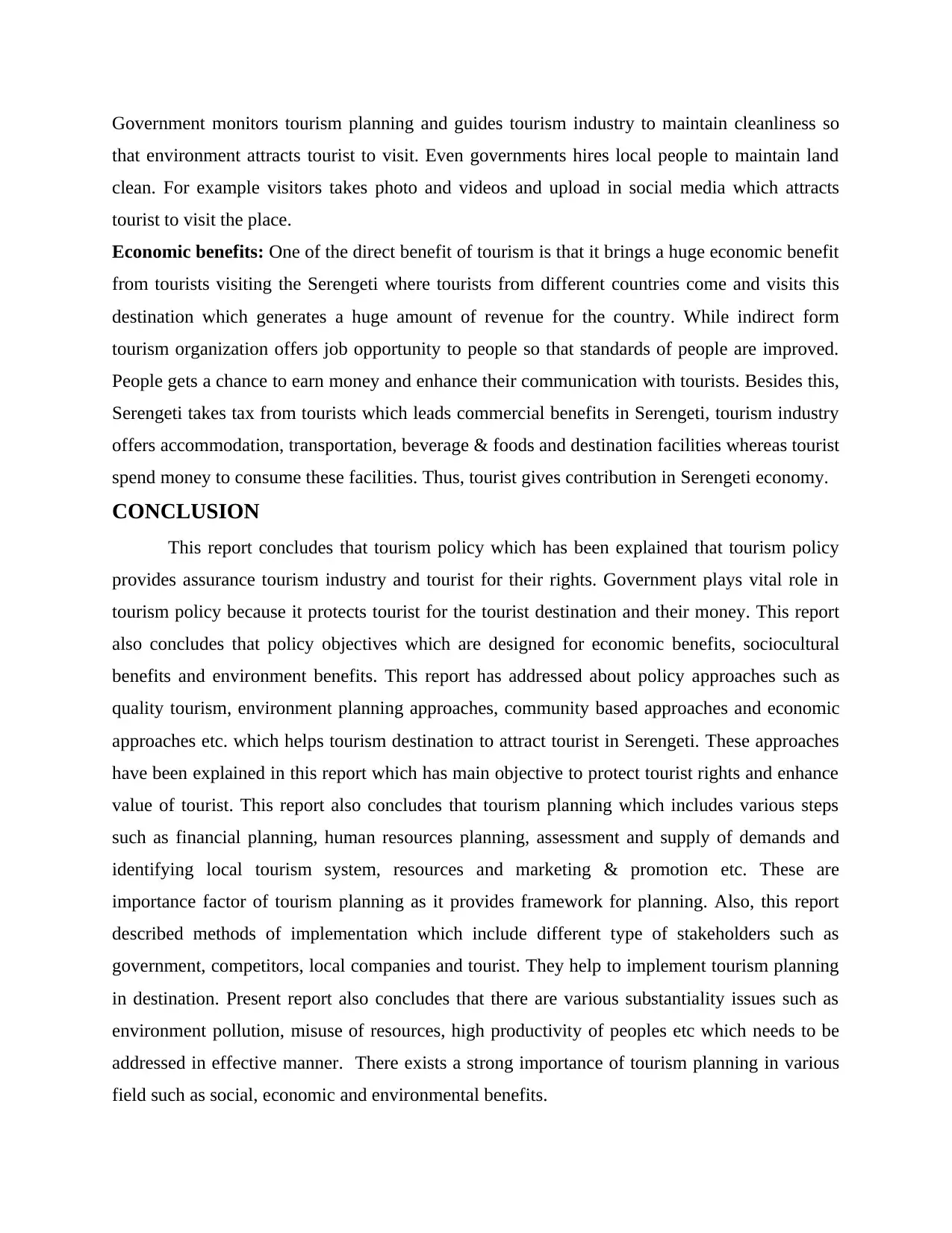
Government monitors tourism planning and guides tourism industry to maintain cleanliness so
that environment attracts tourist to visit. Even governments hires local people to maintain land
clean. For example visitors takes photo and videos and upload in social media which attracts
tourist to visit the place.
Economic benefits: One of the direct benefit of tourism is that it brings a huge economic benefit
from tourists visiting the Serengeti where tourists from different countries come and visits this
destination which generates a huge amount of revenue for the country. While indirect form
tourism organization offers job opportunity to people so that standards of people are improved.
People gets a chance to earn money and enhance their communication with tourists. Besides this,
Serengeti takes tax from tourists which leads commercial benefits in Serengeti, tourism industry
offers accommodation, transportation, beverage & foods and destination facilities whereas tourist
spend money to consume these facilities. Thus, tourist gives contribution in Serengeti economy.
CONCLUSION
This report concludes that tourism policy which has been explained that tourism policy
provides assurance tourism industry and tourist for their rights. Government plays vital role in
tourism policy because it protects tourist for the tourist destination and their money. This report
also concludes that policy objectives which are designed for economic benefits, sociocultural
benefits and environment benefits. This report has addressed about policy approaches such as
quality tourism, environment planning approaches, community based approaches and economic
approaches etc. which helps tourism destination to attract tourist in Serengeti. These approaches
have been explained in this report which has main objective to protect tourist rights and enhance
value of tourist. This report also concludes that tourism planning which includes various steps
such as financial planning, human resources planning, assessment and supply of demands and
identifying local tourism system, resources and marketing & promotion etc. These are
importance factor of tourism planning as it provides framework for planning. Also, this report
described methods of implementation which include different type of stakeholders such as
government, competitors, local companies and tourist. They help to implement tourism planning
in destination. Present report also concludes that there are various substantiality issues such as
environment pollution, misuse of resources, high productivity of peoples etc which needs to be
addressed in effective manner. There exists a strong importance of tourism planning in various
field such as social, economic and environmental benefits.
that environment attracts tourist to visit. Even governments hires local people to maintain land
clean. For example visitors takes photo and videos and upload in social media which attracts
tourist to visit the place.
Economic benefits: One of the direct benefit of tourism is that it brings a huge economic benefit
from tourists visiting the Serengeti where tourists from different countries come and visits this
destination which generates a huge amount of revenue for the country. While indirect form
tourism organization offers job opportunity to people so that standards of people are improved.
People gets a chance to earn money and enhance their communication with tourists. Besides this,
Serengeti takes tax from tourists which leads commercial benefits in Serengeti, tourism industry
offers accommodation, transportation, beverage & foods and destination facilities whereas tourist
spend money to consume these facilities. Thus, tourist gives contribution in Serengeti economy.
CONCLUSION
This report concludes that tourism policy which has been explained that tourism policy
provides assurance tourism industry and tourist for their rights. Government plays vital role in
tourism policy because it protects tourist for the tourist destination and their money. This report
also concludes that policy objectives which are designed for economic benefits, sociocultural
benefits and environment benefits. This report has addressed about policy approaches such as
quality tourism, environment planning approaches, community based approaches and economic
approaches etc. which helps tourism destination to attract tourist in Serengeti. These approaches
have been explained in this report which has main objective to protect tourist rights and enhance
value of tourist. This report also concludes that tourism planning which includes various steps
such as financial planning, human resources planning, assessment and supply of demands and
identifying local tourism system, resources and marketing & promotion etc. These are
importance factor of tourism planning as it provides framework for planning. Also, this report
described methods of implementation which include different type of stakeholders such as
government, competitors, local companies and tourist. They help to implement tourism planning
in destination. Present report also concludes that there are various substantiality issues such as
environment pollution, misuse of resources, high productivity of peoples etc which needs to be
addressed in effective manner. There exists a strong importance of tourism planning in various
field such as social, economic and environmental benefits.
Paraphrase This Document
Need a fresh take? Get an instant paraphrase of this document with our AI Paraphraser

REFERENCES
Books and Journals
Omar, C.M.C., 2019. EXPLORING THE VALIDATION OF ISLAMIC HOSPITALITY
MANAGEMENT IN TOURISM DESTINATION: MALAYSIAN PERSPECTIVES.
Journal of Hospitality and Networks. 1(1). pp.34-43.
Sheresheva, M.Y., 2018. The Russian hospitality and tourism market: What factors affect
diversity and new destination development?. Worldwide Hospitality and Tourism
Themes. 10(4). pp.510-522.
Björk, P. and Kauppinen-Räisänen, H., 2016. Local food: a source for destination attraction.
International Journal of Contemporary Hospitality Management. 28(1). pp.177-194.
Teare, R., 2019. Worldwide Hospitality and Tourism Themes.
Mihalič, T., 2016. The Impact of Innovativeness on Mountain Destination Development. In
Competence-Based Innovation in Hospitality and Tourism (pp. 155-178). Routledge.
Dinis, M.G., Breda, Z. and Barreiro, T., 2020. Digital Marketing Strategies of Destination
Management Organizations: An Exploratory Study. In Strategic Business Models to
Support Demand, Supply, and Destination Management in the Tourism and Hospitality
Industry (pp. 266-285). IGI Global.
Van Niekerk, M., 2017. Contemporary issues in events, festivals and destination management.
International Journal of Contemporary Hospitality Management. 29(3). pp.842-847.
Adeyinka-Ojo, S. and Abdullah, S.K., 2019, April. Disruptive Digital Innovation and Sharing
Economy in Hospitality and Tourism Destination. In IOP Conference Series: Materials
Science and Engineering (Vol. 495, No. 1, p. 012006). IOP Publishing.
Nunkoo, R. ed., 2018. Handbook of Research Methods for Tourism and Hospitality
Management. Edward Elgar Publishing.
Almeida-Santana, A. and Moreno-Gil, S., 2018. Understanding tourism loyalty: Horizontal vs.
destination loyalty. Tourism Management, 65, pp.245-255.
Miličević, K., Mihalič, T. and Sever, I., 2017. An investigation of the relationship between
destination branding and destination competitiveness. Journal of travel & tourism
marketing. 34(2). pp.209-221.
Perpiña, L., Camprubí, R. and Prats, L., 2019. Destination image versus risk perception. Journal
of Hospitality & Tourism Research. 43(1). pp.3-19.
Kozak, M. and Kozak, N. eds., 2015. Destination marketing: An international perspective.
Routledge.
Books and Journals
Omar, C.M.C., 2019. EXPLORING THE VALIDATION OF ISLAMIC HOSPITALITY
MANAGEMENT IN TOURISM DESTINATION: MALAYSIAN PERSPECTIVES.
Journal of Hospitality and Networks. 1(1). pp.34-43.
Sheresheva, M.Y., 2018. The Russian hospitality and tourism market: What factors affect
diversity and new destination development?. Worldwide Hospitality and Tourism
Themes. 10(4). pp.510-522.
Björk, P. and Kauppinen-Räisänen, H., 2016. Local food: a source for destination attraction.
International Journal of Contemporary Hospitality Management. 28(1). pp.177-194.
Teare, R., 2019. Worldwide Hospitality and Tourism Themes.
Mihalič, T., 2016. The Impact of Innovativeness on Mountain Destination Development. In
Competence-Based Innovation in Hospitality and Tourism (pp. 155-178). Routledge.
Dinis, M.G., Breda, Z. and Barreiro, T., 2020. Digital Marketing Strategies of Destination
Management Organizations: An Exploratory Study. In Strategic Business Models to
Support Demand, Supply, and Destination Management in the Tourism and Hospitality
Industry (pp. 266-285). IGI Global.
Van Niekerk, M., 2017. Contemporary issues in events, festivals and destination management.
International Journal of Contemporary Hospitality Management. 29(3). pp.842-847.
Adeyinka-Ojo, S. and Abdullah, S.K., 2019, April. Disruptive Digital Innovation and Sharing
Economy in Hospitality and Tourism Destination. In IOP Conference Series: Materials
Science and Engineering (Vol. 495, No. 1, p. 012006). IOP Publishing.
Nunkoo, R. ed., 2018. Handbook of Research Methods for Tourism and Hospitality
Management. Edward Elgar Publishing.
Almeida-Santana, A. and Moreno-Gil, S., 2018. Understanding tourism loyalty: Horizontal vs.
destination loyalty. Tourism Management, 65, pp.245-255.
Miličević, K., Mihalič, T. and Sever, I., 2017. An investigation of the relationship between
destination branding and destination competitiveness. Journal of travel & tourism
marketing. 34(2). pp.209-221.
Perpiña, L., Camprubí, R. and Prats, L., 2019. Destination image versus risk perception. Journal
of Hospitality & Tourism Research. 43(1). pp.3-19.
Kozak, M. and Kozak, N. eds., 2015. Destination marketing: An international perspective.
Routledge.

⊘ This is a preview!⊘
Do you want full access?
Subscribe today to unlock all pages.

Trusted by 1+ million students worldwide
1 out of 12
Related Documents
Your All-in-One AI-Powered Toolkit for Academic Success.
+13062052269
info@desklib.com
Available 24*7 on WhatsApp / Email
![[object Object]](/_next/static/media/star-bottom.7253800d.svg)
Unlock your academic potential
Copyright © 2020–2025 A2Z Services. All Rights Reserved. Developed and managed by ZUCOL.




